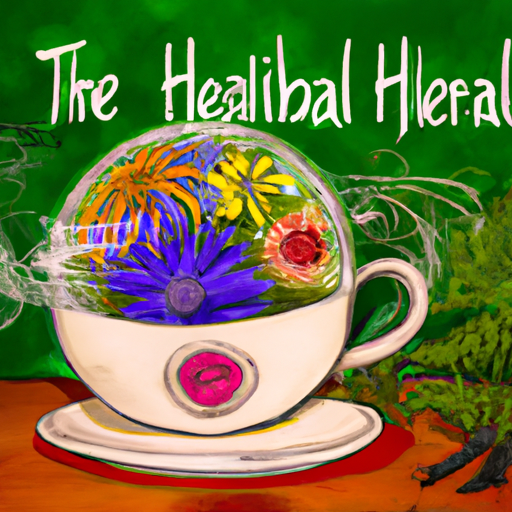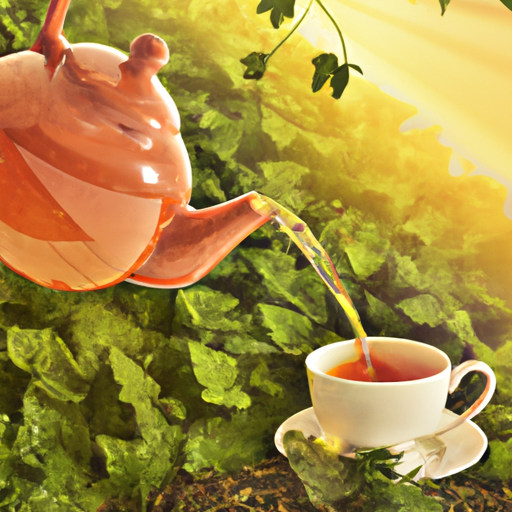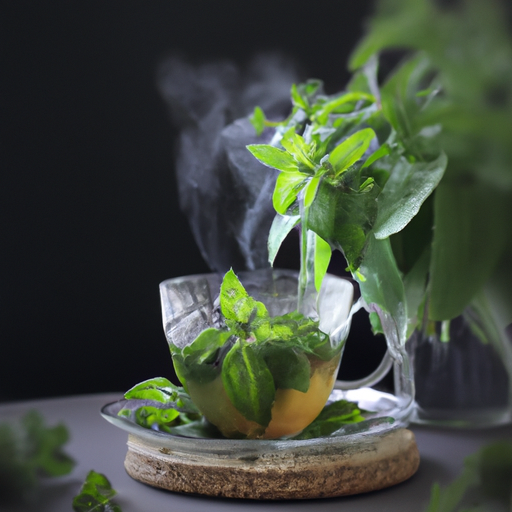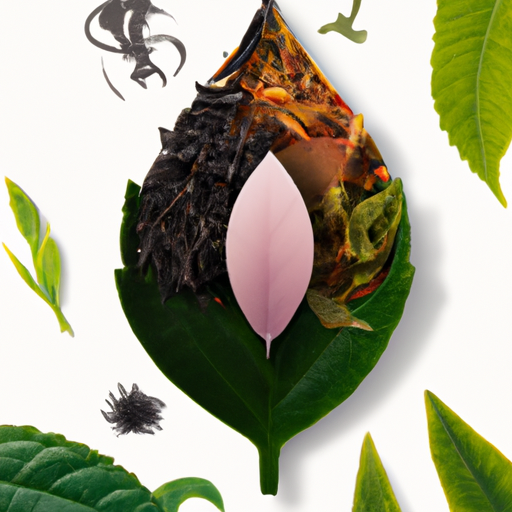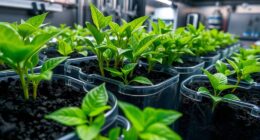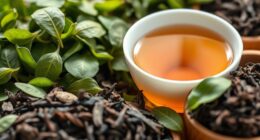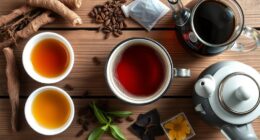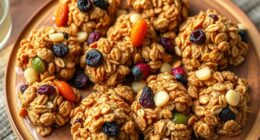Welcome, tea enthusiasts, to this enlightening exploration into the world of herbal infusions. Have you ever wondered why herbal tea is not considered a ‘real’ tea? Join me as we delve into the depths of the tea world and uncover the truth behind this perplexing question.
The definition of true tea lies in its origins, derived from the leaves of the Camellia Sinensis plant. These leaves, carefully cultivated and skillfully processed, give birth to the beloved black, green, white, and oolong teas. However, herbal tea, often referred to as tisanes, takes a different path.
Herbal tea is a delightful alternative, crafted from an array of ingredients such as flowers, fruits, herbs, and spices. These diverse elements offer a cornucopia of flavors and aromas, providing a unique and personalized tea experience. But why does it fall outside the realm of ‘real’ tea?
In this article, we will explore the distinction between true tea and herbal infusions, uncovering the health benefits, differences in flavor and aroma, and why embracing this delightful alternative is a wise choice.
So, dear readers, let us embark on this tea-filled journey and quench our thirst for knowledge.
Key Takeaways
- Herbal tea is not derived from the Camellia Sinensis plant.
- True tea is made from the leaves of the Camellia Sinensis plant and undergoes specific processing methods.
- Herbal teas, or tisanes, are made from a variety of ingredients such as flowers, fruits, herbs, and spices.
- True tea has a rich history and cultural significance in Asian countries.
The Definition of True Tea
Herbal tea may be a popular choice for many, but it’s important to understand that it doesn’t meet the true tea definition. True tea is derived from the leaves of the Camellia sinensis plant, which is native to Asia.
These leaves undergo a specific process involving withering, rolling, oxidation, and drying, resulting in the different types of true tea, such as green, black, oolong, and white tea.
Herbal infusions, on the other hand, are made from the infusion of various herbs, flowers, fruits, and spices, but do not contain any leaves from the Camellia sinensis plant.
The distinction between true tea and herbal infusions is not only botanical but also cultural. True tea has a rich history and cultural significance in many Asian countries, where it is not only consumed for its taste but also for its ceremonial and medicinal purposes. It has been a part of traditional Chinese, Japanese, and Indian cultures for centuries, and its consumption is deeply ingrained in their customs and rituals.
Now, let’s delve into the key ingredient that makes true tea what it is: the Camellia sinensis leaves.
Camellia Sinensis Leaves: The Key Ingredient
The potent power of the Camellia Sinensis leaves is the pivotal component in producing a proper and palatable cup of tea. These leaves are cultivated in various regions around the world, including China, India, and Japan. The cultivation process involves careful attention to detail, from selecting the right soil and climate conditions to ensuring proper irrigation and pest control. This meticulous approach guarantees the highest quality leaves, which are then harvested and processed to create different types of tea.
To paint a picture for the audience, imagine a vast tea plantation with rows upon rows of lush green tea bushes. The air is filled with the sweet aroma of tea leaves as skilled workers carefully pluck the young, tender leaves by hand. These leaves are then dried and undergo various processing methods, such as oxidation or steaming, to bring out their unique flavors and characteristics.
Unlike herbal infusions, which are made from a variety of plant materials like flowers, fruits, and herbs, true tea is solely derived from the leaves of the Camellia Sinensis plant. This distinction is crucial because it’s the Camellia Sinensis leaves that contain the natural compounds and antioxidants that give tea its health benefits and distinct flavors.
Now that we understand the importance of the Camellia Sinensis leaves in tea production, let’s delve into the origins of herbal tea and how it differs from true tea.
The Origins of Herbal Tea
Originating from ancient civilizations, herbal tea has a rich history that dates back to the early cultivation of medicinal plants and the discovery of their soothing and healing properties. Herbal tea holds great cultural significance in different cultures around the world. It has been used for centuries as a natural remedy for various ailments and as a way to promote overall well-being.
To give you a glimpse into the diverse cultural practices surrounding herbal tea, here is a table showcasing some of the popular herbal teas and their origins:
| Herbal Tea | Cultural Significance | Origin |
|---|---|---|
| Chamomile | Relaxation and sleep | Ancient Egypt |
| Peppermint | Digestive health | Ancient Greece |
| Rooibos | Antioxidant properties | South Africa |
| Ginseng | Energy and vitality | Traditional Chinese |
These examples highlight the wide range of uses and benefits associated with herbal tea. From promoting relaxation to improving digestion, herbal teas have become an integral part of many cultural practices.
Moving forward, we will explore the variety of ingredients found in herbal tea, which contribute to its distinct flavors and health-promoting properties.
The Variety of Ingredients in Herbal Tea
With a blend of diverse ingredients, herbal tea becomes a symphony of flavors, like a melodic orchestra playing a harmonious tune. The variety of ingredients found in herbal teas is vast, ranging from leaves and flowers to fruits and spices. This wide selection allows for an endless array of flavors and aromas, ensuring that there’s something for everyone’s taste buds.
Herbal teas often include ingredients such as chamomile, peppermint, lavender, hibiscus, and rosehips, just to name a few. Each ingredient brings its own unique flavor profile and health benefits to the table. Chamomile, for example, is known for its calming properties, while peppermint aids in digestion. Lavender has a soothing effect, and hibiscus provides a tart and refreshing taste. The combination of these ingredients creates a delightful and refreshing beverage.
Not only do herbal teas offer a wide variety of flavors, but they also provide numerous health benefits. Many ingredients found in herbal teas have been used for centuries for their medicinal properties. For example, chamomile can help with sleep and relaxation, while ginger can aid in digestion. These teas are often caffeine-free, making them a great alternative for those looking to reduce their caffeine intake.
As we delve into the health benefits of herbal tea, we’ll discover how these natural ingredients can positively impact our well-being, promoting a healthier lifestyle.
Health Benefits of Herbal Tea
Experience the multitude of health benefits that herbal tea has to offer, from soothing chamomile for a good night’s sleep to digestion-aiding ginger for a happier tummy.
Herbal tea is not only a comforting and delicious beverage, but it also provides a wide range of health benefits. One of the key advantages of herbal tea is its ability to promote relaxation and improve sleep quality. Chamomile, for example, contains compounds that have a calming effect on the body, making it an excellent choice for those struggling with insomnia or anxiety.
Additionally, herbal teas like ginger can aid in digestion by reducing inflammation and soothing the stomach.
Moreover, herbal teas are packed with antioxidants that help fight free radicals and protect the body from damage. These antioxidants can boost the immune system and reduce the risk of chronic diseases, such as heart disease and certain types of cancer.
Another benefit of herbal tea is its potential to support weight loss. Some herbal teas, like green tea, have been shown to increase metabolism and promote fat burning.
When it comes to brewing methods, herbal tea is quite versatile. Most herbal teas can be steeped in hot water for several minutes to release their flavors and medicinal properties. However, some herbal teas, like hibiscus, are best brewed with boiling water and steeped for a shorter period to prevent bitterness. It’s important to follow the recommended brewing instructions for each type of herbal tea to ensure the best taste and maximum health benefits.
Herbal tea offers a plethora of health benefits, from promoting relaxation and aiding digestion to boosting the immune system and aiding weight loss. By incorporating herbal teas into your daily routine, you can enjoy these benefits while indulging in a delicious and soothing beverage.
Speaking of indulgence, let’s explore the differences in flavor and aroma that make herbal teas a unique and delightful experience.
Differences in Flavor and Aroma
Get ready to tantalize your taste buds with the delightful array of flavors and aromas that herbal teas have to offer. One of the reasons why herbal teas are so unique is because of their diverse flavor profiles. From fruity and floral to earthy and spicy, there’s a herbal tea for every taste preference. Each herb used in herbal teas has its own distinct taste, allowing for endless combinations and experimentation. Whether you prefer the sweet and soothing taste of chamomile or the refreshing zest of peppermint, there’s a herbal tea that’ll cater to your cravings.
In addition to their varied flavors, herbal teas also offer a wide range of aromas. The scent of a freshly brewed herbal tea can be invigorating and comforting at the same time. The aromas can range from light and subtle to strong and robust, depending on the herbs used and the brewing techniques employed.
When it comes to brewing herbal teas, there are different techniques that can be utilized to enhance the flavors and aromas. Some herbs are best steeped with boiling water, while others benefit from a longer infusion time. Experimenting with different brewing methods can help you find the perfect balance of taste and aroma for your desired cup of herbal tea.
Embracing the delightful alternative to traditional tea is a journey that’ll take you on a flavorful and aromatic adventure.
Embracing the Delightful Alternative
Indulge in the delightful alternative that’ll transport your taste buds on a mesmerizing journey of flavor and aroma. Herbal infusions, though not technically considered ‘real tea,’ offer a world of alternative options for tea enthusiasts.
With a wide range of ingredients, from chamomile to peppermint, these herbal blends provide unique and enticing flavors that can cater to any palate. Here are four reasons why embracing herbal teas can be a delightful experience:
-
Natural and caffeine-free: Unlike traditional tea, herbal infusions are caffeine-free, making them a perfect choice for those looking to reduce their caffeine intake or enjoy a relaxing cup before bed.
-
Health benefits: Many herbs used in herbal teas are known for their medicinal properties. For example, chamomile is often consumed for its calming effects, while ginger can aid in digestion.
-
Endless flavor possibilities: With countless herbs, spices, and flowers to choose from, the flavor combinations in herbal teas are virtually limitless. From fruity and floral to earthy and spiced, there’s a herbal blend for every taste preference.
-
Brewing techniques: Herbal teas require different brewing techniques compared to traditional tea. It’s essential to experiment with varying water temperatures and steeping times to unlock the full potential of the herbs and extract their flavors.
So, next time you’re craving a cup of tea, consider exploring the world of herbal infusions. You’ll be amazed at the delightful alternative options and brewing techniques available to enhance your tea-drinking experience.
Frequently Asked Questions
Are there any health benefits of true tea made from Camellia Sinensis leaves?
As an avid tea drinker, I can confidently say that true tea made from camellia sinensis leaves offers numerous health benefits. From boosting metabolism to improving heart health, its preparation methods vary, including steeping, brewing, and matcha preparation.
What are the different flavors and aromas of true tea?
Different types of herbal tea flavors include fruity, floral, earthy, and spicy. Exploring the various herbal tea aromas reveals a wide range of scents such as mint, chamomile, lavender, and cinnamon.
Can herbal tea be considered a real tea if it doesn’t contain Camellia Sinensis leaves?
Herbal tea, although caffeine-free and lacking camellia sinensis leaves, offers a delightful alternative to traditional tea. Through a comparison of herbal tea and traditional tea, we can explore a world of diverse and flavorful options.
Are there any differences in the variety of ingredients between true tea and herbal tea?
There are significant differences in the variety of ingredients between true tea and herbal tea. True tea comes from the Camellia sinensis plant, while herbal tea can be made from a wide range of plants and herbs. Additionally, true tea has different brewing techniques and its flavor is influenced by terroir.
Why should we embrace herbal tea as a delightful alternative to true tea?
Embracing herbal tea as a delightful alternative to true tea is beneficial for several reasons. Herbal teas offer a wide variety of flavors and health benefits, making them a refreshing and soothing option for tea lovers.
Conclusion
In conclusion, herbal tea may not be classified as a ‘true tea’ because it doesn’t contain leaves from the Camellia Sinensis plant. However, this doesn’t diminish its value or appeal. Herbal teas offer a wide range of ingredients and flavors, along with numerous health benefits.
So, while it may not fit the traditional definition of tea, embracing the delightful alternative of herbal tea can bring joy and wellness into our lives. Give it a try, and you might just discover a new favorite beverage.

